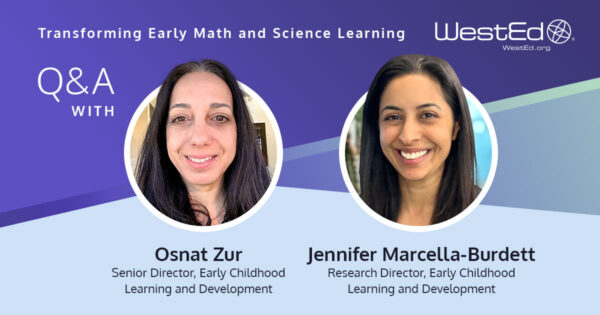
August 8, 2025
“The progressions help educators recognize learning pathways and how to support every child’s growth with purposeful, developmentally appropriate strategies.”
—Osnat Zur, Director of Early Childhood Learning and Development at WestEd
What if every transition in a child’s early education from preschool through 3rd grade felt seamless, supportive, and aligned with how children grow and learn?
When educators have access to clear, developmentally informed guidance, they’re better able to meet the diverse needs of young learners. That idea is the foundation of the California Department of Education’s (CDE) newly launched Preschool Through Third Grade (P–3) Learning Progressions.
The P–3 Learning Progressions support educators, administrators, and instructional leaders in creating cohesive learning experiences from preschool through 3rd grade. The P–3 Progressions complement standards and curriculum frameworks by clarifying how learning expectations evolve across the early grades and how educators can use this developmental approach to support individual children based on the children’s strengths and needs. This continuity enables both instruction that is more aligned and effective support for each child’s learning and development.
WestEd’s Early Childhood Learning and Development team partnered with the CDE to lead the development of the P–3 Learning Progressions that center the realities of California’s classrooms and programs, recognizing that children bring a wide range of developmental, linguistic, and cultural experiences to school. The progressions were designed to be both reflective of these diverse experiences and responsive to them.
Clarifying Developmental Pathways Across the Early Years
Children’s earliest years in school lay the foundation for all future learning. Too often, however, early learning and elementary education are disconnected—operating with different expectations, terminology, and approaches. The P–3 Learning Progressions aim to bridge those divides.
Developed in collaboration with researchers, educators, and field experts, the progressions focus on typical learning pathways in five domains:
- Approaches to Learning
- Social and Emotional Development
- Language and Literacy Development
- Mathematics
- Science
Learning progressions in each domain are grounded in current research and reflect a deep understanding of the wide range of developmental pathways children may follow. The learning progressions help educators understand how learning builds over time and provides practical guidance to support children at different points in their developmental journey.
The P–3 Learning Progressions include in-practice examples that illustrate how educators support developmentally appropriate, culturally meaningful, and joyful learning through various approaches. These examples show how children develop skills and knowledge across grade levels and highlight teaching strategies that support children’s learning and development. The in-practice examples also demonstrate how educators build on the strengths and lived experiences of multilingual learners and children from a variety of communities and backgrounds and respond to individual strengths and areas of support, and encourage active participation.
In the in-practice examples that illustrate the progression of counting and cardinality in math, young students in preschool and 1st grade engage in comparing numbers through a meaningful investigation—deciding based on votes whether to plant blue corn or okra seeds. Children’s ability develops from comparing a smaller (6 vs. 8) to comparing a larger number of votes (28 vs. 32). However, in both cases the teacher supports students’ learning by providing hands-on materials like sticks or counting chips to help children group and compare quantities, encourages them to explain their reasoning using mathematical language, adapts learning experiences to include children with disabilities, and fosters communication in both English and their home languages. This approach creates an inclusive, individually sustaining environment that makes math relevant and accessible.
While the progressions highlight the developmental pathways children may follow, children’s learning isn’t always linear. Development unfolds uniquely for each child, shaped by their experiences, environment, and pace. Periods of rapid growth may be followed by stretches of consolidation, and that ebb and flow is both natural and expected.
When a child’s progress raises concerns, educators can partner with families and draw on evidence-based interventions to better understand the child’s needs, support their growth, and determine whether additional specialized services (e.g., speech therapy, occupational therapy) or interventions may be helpful. Thoughtful collaboration with families and specialized services ensures every child has the opportunity to thrive.
The Power of Play and Purposeful Practice
One of the unique features of the P–3 Learning Progressions is the emphasis on playful learning. The progressions acknowledge what decades of research and practice have affirmed: Play is a powerful vehicle for engagement, exploration, and development.
The progressions support a variety of approaches to playful learning, including child-initiated exploration and educator-guided activities that help children make meaning of their world. Play is not a replacement for educator-guided instruction but rather a complement to it. When integrated intentionally, play fosters curiosity, deepens understanding, and creates joyful connections between learning and children’s lived experiences.
Supporting Stronger, More Connected Learning
The P–3 Learning Progressions represent more than a developmental framework; they reflect a shared vision for strengthening California’s early learning efforts. By promoting continuity from preschool through 3rd grade, the learning progressions can help reduce instructional gaps, ease transitions between grade levels, and ensure that children experience consistent, responsive support.
When educators can access research-based, actionable guidance that honors the diverse developmental pathways children take, they can more effectively foster confident, capable learners. The P–3 Learning Progressions are a step toward making that a reality across California—helping educators not only deepen their understanding of how skills develop but also apply strategies to meet children where they are.
Our team brings a comprehensive combination of research expertise, deep knowledge of child development, and hands-on experience supporting state education systems. If your state is ready to strengthen the connection between early learning and the elementary years, we’re ready to help. Partner with WestEd to develop a coherent, developmentally informed P–3 system that supports all young learners from the very start. Contact us to explore how we can work together.










